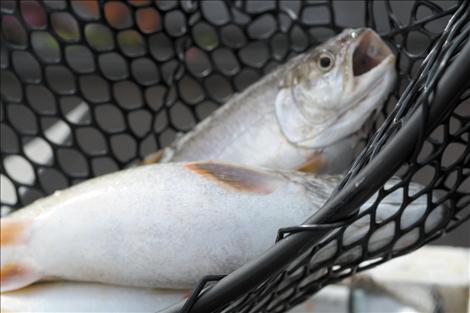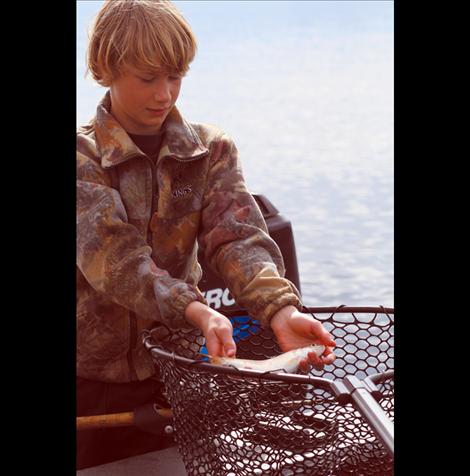Mack Days EIS complete, tourney future to be decided mid-August
Hey savvy news reader! Thanks for choosing local.
You are now reading
3 of 3 free articles.
POLSON — Mack Days began 12 years ago as a management tool aimed at reducing Flathead Lake’s lake trout population while increasing the native bull and cutthroat trout populations.
After more than a decade, CSKT fisheries biologist Barry Hansen said the twice-annual fishing tournament has not measurably changed the lake trout population. With this in mind, the CSKT commissioned an environmental impact statement to take an in-depth look at alternative options and tools available to wildlife managers.
In a previous interview with the Valley Journal, CSKT Fish, Wildlife, Recreation and Conservation division manager Tom McDonald said the EIS contains the highest level of research that is needed for disclosure or public involvement, as it requires the most due process and the most study. As such, he was confident the study will help lead the tribes to the right decision.
The study took place during the spring and was completed recently, and a copy is available at the tournament’s website, www.MackDays.com. CSKT fisheries biologist Cindy Bras-Benson said the EIS is open for public comment for the next 45 days. Public comments are accepted in writing or via the website.
“The tribal fisheries program will compile and summarize all public comments and present that information to the tribal council,” Bras-Benson said. “The tribal council has the final decision as to which alternative of the four they will more forward with. The deadline (for public comments) is August 5. By mid-August, we will be taking these recommendations to the council for their decision.”
The baseline for the EIS model was Mack Days, i.e. what is being done by fishery managers right now to reduce lake trout populations.
Three alternatives proposing 25, 50 and 73-percent population reductions are being considered. Hansen said none of the options is a full-restoration initiative, and that the biggest factor in native trout species decline is lake trout.
According to the EIS, lake trout became abundant only after the mysis shrimp introduction which led to the extirpation of kokanee salmon and the decline of native fish from Flathead Lake.
To benefit these native fish and bring their numbers back up, the fisheries program has liberalized fishing regulations and instituted the Mack Days program. Benson said the EIS alternatives go beyond that, identifying specific harvest targets to achieve specific percent reductions in lake trout populations.
The current lake trout population of Flathead Lake identified in the EIS is 1.35 million fish ages four and older. Benson said officials chose this age as the cutoff because age four is when the trout generally grow to about 12 inches and begin entering into the fishery tourney.
Unfortunately, Benson said there is a good deal of misinformation regarding the purpose and goals of the EIS.
“There’s a lot of information in the EIS, and there’s a lot of talk going on about it, so it’s a challenge to get to the bottom of things and sort through the facts and rumors,” he said. “There’s a lot of chatter, and a lot of that chatter is off-base.
“Our purpose is to benefit native fish. There are those that characterize what we’re doing as just gill netting. That’s only one of many methods in the EIS, and what we’re doing is identifying those percent reductions and methods to get there. Each one starts with anglers and essentially gives them a shot to get to that target. If the target isn’t reached by anglers, additional tools come to bear.”
The additional tools identified in the EIS include bounties, commercial fishing, gill netting and trap netting. Hansen said he often hears concerns regarding gill netting and its potential to result in a large amount of binetting (catching fish that are not your target which include, in this case, anything but lake trout). However, Hansen called gill netting a “tool of last resort.”
“I often hear that the bi-catch will be so severe that the benefits to native fish will not be realized,” he said. “We’ve analyzed that and quantified it, and predicted what the bicatch will be. If and when we get to the point of implementation, we would monitor and learn, adapt and adjust our program to reduce bi-catch. While (bi-catch) cannot be ignored, it’s something that we’re pretty confident we can manage and keep to a minimum.”
Other fears include the possibility of a sterile lake where no fishing opportunity exists. Hansen said this is also incorrect, as a percent reductions of fish populations does not result in a one-to-one ratio for anglers.
“Catch rates decline much more gradually,” he said. “This is addressed in great detail in the EIS and we think then that the concerns in the changes in fishing are not justified.”
If the tribes choose not to pursue any of the alternatives, fishery managers and fishery employees are left with the status quo of Mack Days, which is not working.
Fisheries officials have said in the past that the primary method they know of to benefit native trout populations is to reduce the abundance of lake trout. As the status quo is unacceptable, they would have to chart a new direction which, by definition, could not emphasize native fish.
Hansen said he is confident that things will get better for native trout if the final selection is one of the action alternatives. However, he added that there are those who oppose the EIS alternatives, saying it is not unanimously supported and he feels there is a fair bit of fear-mongering going on.
“It’s frustrating for us because those who have voiced opposition don’t provide evidence to support their arguments,” he said.
Regardless, Hansen said he is very pleased with the final product and hopes it will aid in the final decision.
“I am confident and happy that we have covered all the issues and present all the information in a document that will be very helpful to a decision maker, but there’s a lot of variables that come into the final decision, and those are above my pay grade,” he said. “I can’t address those, but we’re happy with the document we have.”

















